Introduction
In the realm of education, especially within child care setups, emergency situations can occur at any moment. Understanding immediate feedback obligations is critical for educators, caregivers, and moms and dads alike. Not just does it include basic emergency treatment knowledge, yet it additionally entails a collection of methods and abilities that need to be understood to make sure the safety and security of children. From handling small wounds to administering an EpiPen during an allergy, this comprehensive guide will look into the myriad responsibilities that come with instant actions in instructional environments.
Immediate Response Responsibilities: What to Do When Emergency situations Arise
The term "instant feedback duties" refers to the activities and decisions that require to be taken when an emergency occurs. These scenarios can range from minor cases like playground incidents to much more severe situations including clinical emergency situations. The emphasis right here gets on quick responses that can significantly influence the end result for youngsters involved.
Understanding Emergency Scenarios in Education
Emergency circumstances can differ commonly in nature and extent. Some typical instances consist of:
- Choking Incidents: Kids might inadvertently choke on food or tiny objects. Allergic Reactions: Circumstances needing EpiPen administration due to severe allergies. Minor Injuries: Scrapes, cuts, and bruises from play. Medical Emergencies: Bronchial asthma strikes or seizures that require instant attention.
Recognizing Bronchial asthma Symptoms in Children
Asthma is a prevalent condition among children and recognizing how to identify its signs can save lives. Usual indicators consist of:
- Coughing frequently Shortness of breath Wheezing noises when exhaling Chest tightness
Choking Avoidance Strategies for Educators
Preventing choking incidents ought to be a concern in educational settings. Below are some effective methods:
Age-Appropriate Foods: Make certain that food provided appropriates for kids's ages. Supervision During Meals: Constantly screen youngsters while they eat. Education on Food Choices: Show kids concerning foods that present choking hazards.EpiPen Administration Protocols
When handling allergies, EpiPens can be life-saving devices. Here's how to provide one:
Remove the EpiPen from its case. Hold the EpiPen strongly and eliminate the safety cap. Press the suggestion versus the external upper leg till it clicks. Hold it in position for about 10 seconds prior to removing. blended cprManaging Minor Wounds Effectively
Injuries are inescapable when managing energetic children; thus, comprehending how to take care of small injuries is crucial:
Clean the wound with soap and water. Apply a disinfectant solution. Cover with a clean and sterile bandage.Child Defibrillation Guidance
For major instances where a child might experience cardiac arrest, understanding exactly how to use an AED (Automated External Defibrillator) is crucial:
Turn on the AED and comply with voice prompts. Attach pads as shown on the device. Ensure no person is touching the youngster before supplying a shock if recommended by the AED.Building Teacher Confidence Through Training
Educators play a crucial function in emergency situation feedback circumstances; for this reason it's crucial they feel confident in their capabilities:
HLTAID012 Accreditation Australia Overview
The HLTAID012 qualification outfits educators with essential first aid abilities tailored especially for educational settings:

- Duration of training normally extends over numerous hours including both written and functional components. It covers topics such as CPR techniques, managing injuries, and incident coverage protocols.
Written vs Practical Elements of First Aid Training
Training programs like HLTAID012 comprise both theoretical expertise and hands-on technique:
|Part|Summary|| --------------------|--------------------------------------------------|| Written|Comprehending methods, regulations, and procedures|| Practical|Hands-on method using mannequins or simulation|
Renewal Timelines for First Aid Certifications
Staying updated with first aid qualifications is essential for teachers:
- Most accreditations need revival every 3 years. Regular updates keep educators educated about new techniques or modifications in protocols.
Childcare Centre Emergency treatment Package Essentials
A well-stocked first aid kit is important in any type of child care centre setting:
Essential Items Include:
Band-aids of different sizes Antiseptic wipes Gauze pads Adhesive tape Disposable gloves ScissorsFirst Aid Essentials for Parents
Parents need to also be geared up with essential first aid understanding:
Know exactly how to treat fevers effectively. Recognize signs of dehydration or warm exhaustion during warm weather. Create a home-based first aid package tailored for childhood years needs.Childcare Safety Dangers Assessment
Regular analyses aid identify potential hazards within child care settings-- some common threats consist of:
Slippery floors Sharp objects within reach Playground devices security checksRegularly examining these threats makes sure safety and security criteria are consistently maintained.

FAQs About Immediate Response Responsibilities
1) What ought to I do if a child chokes?

- Administer back strikes adhered to by abdominal thrusts if they can not take a breath or speak.
2) How usually ought to I restore my HLTAID012 certification?
- Every three years as per Australian regulations.
3) What things are important for a childcare first aid kit?
- Band-aids, antiseptics, gauze pads, scissors, disposable gloves ought to all be included.
4) How can I protect against play area mishaps?
- Conduct normal inspections of play ground equipment and manage youngsters throughout playtime actively.
5) What are bronchial asthma action plans?
- A customized plan established with doctor outlining steps to take during an asthma attack.
6) Exactly how do I acknowledge signs of allergic reactions?
- Look out for hives, swelling around the face or mouth, problem breathing or wheezing noises; act quickly!
Conclusion
Immediate action responsibilities are not simply jobs; they personify a commitment to safeguarding children's health and wellness and health express cpr training within instructional environments. By understanding protocols connected to choking avoidance, EpiPen administration, minor wound management, and more-- teachers can efficiently react when emergency situations arise while with confidence developing trust amongst moms and dads and stakeholders alike.
By staying notified via qualifications like HLTAID012 offer emergency treatment in education training courses and maintaining emergency treatment sets equipped-- everyone figures in in creating safe learning settings conducive to development and exploration while ensuring every child's safety cpr refresher course online remains paramount!